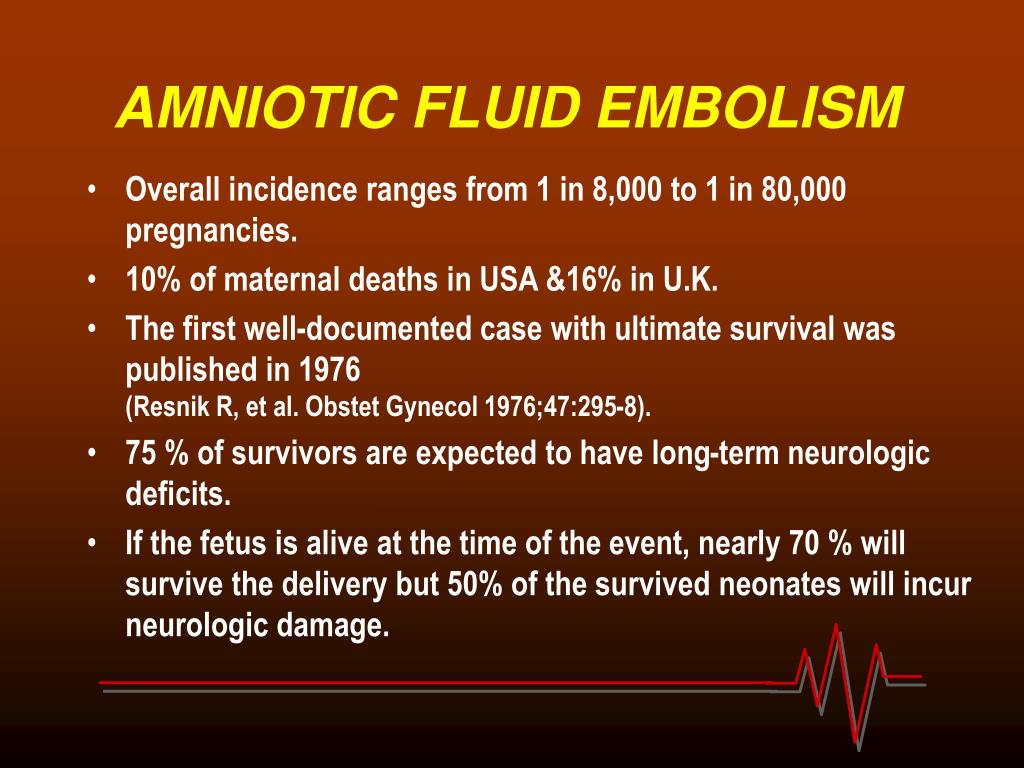


In the event that an AFE occurs during pregnancy, the infant must be expeditiously delivered as a life saving measure for both the mother and fetus. Nonreassuring fetal status is an assessment of fetal health given late in the pregnancy or during delivery. The fetus may not be getting enough oxygen and there may be an abnormally slow heart rate. This term means that the fetus is not doing as well as would normally be expected. In rare instances, severe bleeding (hemorrhaging) may be the first sign of amniotic fluid embolism.ĭoctors may note a condition called nonreassuring fetal status. There may be bleeding from the uterus and from puncture sites, such as the site of an intravenous needle or an epidural catheter. Without these clotting factors, an affected woman cannot create blood clots to stop bleeding. In DIC, blood clotting factors, specialized proteins that help the blood to clot, are used up or broken down. Most women develop a condition called disseminated intravascular coagulation (DIC). Affected women may experience an altered mental status including anxiety or confusion, seizures, or coma. Cardiac arrest can cause gasping breath, no breathing, or complete unresponsiveness in the affected individual. Some affected women experience increasing cardiac rhythm abnormalities, low blood pressure, shock, and/or the abrupt loss of heat function despite no underlying heart disease (cardiac arrest). There may be rapidly high blood pressure in the blood vessels of the lungs (pulmonary hypertension) and sudden narrowing of blood vessels (vasospasm).īreathing problems can progress to acute respiratory failure a severe, life-threatening complication where damage and fluid leakage into the lungs makes breathing difficult or impossible.
AMNIOTIC FLUID EMBOLISM TREATMENT SKIN
Other common initial symptoms include difficulty breathing or shortness of breath (dyspnea), abnormally rapid breathing (tachypnea), low blood pressure (hypotension), an abnormally rapid heartbeat (tachycardia), bluish discoloration of the skin and mucous membranes due to a lack of oxygen (cyanosis) in the blood, and a deficiency in the amount of oxygen reaching the tissues of the body (hypoxia). Nonspecific symptoms including headaches, chest pain, cough, sweating, nausea, and vomiting have been reported as early signs. The signs and symptoms of amniotic fluid embolism often develop rapidly. Early recognition and prompt supportive treatment are essential. Amniotic fluid embolism is a medical emergency that develops suddenly and rapidly and can be fatal. Researchers and physicians do not fully understand why amniotic fluid or fetal cells entering the mother’s bloodstream causes this reaction in some women. Breathing problems, cardiac arrest, and excessive bleeding are some of the life-threatening complications that can occur. For years, some researchers believed that the amniotic fluid and fetal cells cause obstruction within the mother’s blood vessels, but now most researchers believe that the mother’s immune system reacts to the amniotic fluid and fetal cells causing an overwhelming immune system response, which ends up harming the mother and the fetus. AFE can cause a severe, rapid decline in the mother’s health. Amniotic fluid embolism is unpredictable and no risk factors have been identified. This fluid supports, cushions, and protects a developing fetus. Amniotic fluid is contained within the amniotic sac. In this disorder, it is hypothesized that a pregnant woman has a severe, allergic reaction to amniotic fluid or other fetal material such as fetal cells, which enter the mother’s bloodstream.

Stay Informed With NORD’s Email NewsletterĪmniotic fluid embolism (AFE) is an extremely rare, but life-threatening complication that affects pregnant women shortly before, during, or immediately following labor and childbirth.Find a Rare Disease Patient Organization.Find Clinical Trials & Research Studies.Launching Registries & Natural History Studies.A Podcast For The Rare Disease Community.


 0 kommentar(er)
0 kommentar(er)
